A 3D-Printed Do-It-Yourself ELISA Plate Reader as a Biosensor Tested on TNFα Assay
Abstract
:1. Introduction
2. Materials and Methods
2.1. ELISA for TNFα
2.2. The 3D-Printed Colorimetric Biosensor and Its Use
2.3. Data Processing
3. Results and Discussion
4. Conclusions
Author Contributions
Funding
Institutional Review Board Statement
Informed Consent Statement
Data Availability Statement
Acknowledgments
Conflicts of Interest
References
- Ahirwar, R.; Bhattacharya, A.; Kumar, S. Unveiling the underpinnings of various non-conventional ELISA variants: A review article. Expert Rev. Mol. Diagn. 2022, 22, 761–774. [Google Scholar] [CrossRef] [PubMed]
- Daurat, G. Yes, we should keep ABO agglutination test within bedside transfusion checks. Transfus. Clin. Biol. 2008, 15, 322–326. [Google Scholar] [CrossRef] [PubMed]
- Björkman, C.; Uggla, A. Serological diagnosis of Neospora caninum infection. Int. J. Parasit. 1999, 29, 1497–1507. [Google Scholar] [CrossRef] [PubMed]
- Dey, M.K.; Iftesum, M.; Devireddy, R.; Gartia, M.R. New technologies and reagents in lateral flow assay (LFA) designs for enhancing accuracy and sensitivity. Anal. Methods 2023, 15, 4351–4376. [Google Scholar] [CrossRef] [PubMed]
- Ince, B.; Uludag, I.; Demirbakan, B.; Özyurt, C.; Özcan, B.; Sezgintürk, M.K. Lateral flow assays for food analyses: Food contaminants, allergens, toxins, and beyond. TrAC-Trends Anal. Chem. 2023, 169, 24. [Google Scholar] [CrossRef]
- Silva, G.B.L.; Campos, F.V.; Guimaraes, M.C.C.; Oliveira, J.P. Recent Developments in Lateral Flow Assays for Salmonella Detection in Food Products: A Review. Pathogens 2023, 12, 1441. [Google Scholar] [CrossRef]
- Cavalier, E. Determination of parathyroid hormone: From radioimmunoassay to LCMS/MS. Clin. Chem. Lab. Med. 2023, 61, 946–953. [Google Scholar] [CrossRef]
- Liu, R.; Zhang, S.X.; Wei, C.; Xing, Z.; Zhang, S.C.; Zhang, X.R. Metal Stable Isotope Tagging: Renaissance of Radioimmunoassay for Multiplex and Absolute Quantification of Biomolecules. Acc. Chem. Res. 2016, 49, 775–783. [Google Scholar] [CrossRef]
- Guo, M.; Chen, Y.; Mo, X.H.; Wei, H.; Li, Y.Y.; Jia, Y.J.; Hu, F.D.; Du, Y.L. Review-Electrochemical Immunosensors for Depression Markers Detection: Development in Recent Years. J. Electrochem. Soc. 2024, 171, 11. [Google Scholar] [CrossRef]
- Mehta, D.; Gupta, D.; Kafle, A.; Kaur, S.; Nagaiah, T.C. Advances and Challenges in Nanomaterial-Based Electrochemical Immunosensors for Small Cell Lung Cancer Biomarker Neuron-Specific Enolase. ACS Omega 2023, 9, 33–51. [Google Scholar] [CrossRef]
- Evtugyn, G.; Hianik, T. Electrochemical Immuno- and Aptasensors for Mycotoxin Determination. Chemosensors 2019, 7, 10. [Google Scholar] [CrossRef]
- Bergua, J.F.; Alvarez-Diduk, R.; Idili, A.; Parolo, C.; Maymo, M.; Hu, L.; Merkoci, A. Low-Cost, User-Friendly, All-Integrated Smartphone-Based Microplate Reader for Optical-Based Biological and Chemical Analyses. Anal. Chem. 2022, 94, 1271–1285. [Google Scholar] [CrossRef]
- Volpe, C.; Vadstein, O.; Andersen, G.; Andersen, T. Nanocosm: A well plate photobioreactor for environmental and biotechnological studies. Lab Chip 2021, 21, 2027–2039. [Google Scholar] [CrossRef] [PubMed]
- Bagheri, N.; Cinti, S.; Caratelli, V.; Massoud, R.; Saraji, M.; Moscone, D.; Arduini, F. A 96-well wax printed Prussian Blue paper for the visual determination of cholinesterase activity in human serum. Biosens. Bioelectron. 2019, 134, 97–102. [Google Scholar] [CrossRef]
- Seddaoui, N.; Amine, A. Smartphone-based competitive immunoassay for quantitative on-site detection of meat adulteration. Talanta 2021, 230, 10. [Google Scholar] [CrossRef] [PubMed]
- Wang, X.; Wang, H.Y.; Wan, X.Y.; Li, M.J.; Tang, D.P. Smartphone-based photoelectrochemical immunoassay for carcinoembryonic antigen based on BiOCl/CuBi2O4 heterojunction. Anal. Chim. Acta 2023, 1279, 8. [Google Scholar] [CrossRef]
- Li, H.; Ying, Y.; Cao, Z.; Liu, G.Y.; Wang, J. Research Progress on Rapid Detection Technology Based on Smartphone and Lateral Flow Immunoassay. Anal. Chim. Acta 2022, 50, 1–11. [Google Scholar] [CrossRef]
- Ben-Baruch, A. Tumor Necrosis Factor α: Taking a Personalized Road in Cancer Therapy. Front. Immunol. 2022, 13, 6. [Google Scholar] [CrossRef]
- Mikail, M.; Wilson, A. Low Serum Tumor Necrosis Factor-α Antagonist Concentrations in Patients With Inflammatory Bowel Disease Who Achieve Healing From Pyoderma Gangrenosum. Inflamm. Bowel Dis. 2021, 27, E141–E143. [Google Scholar] [CrossRef]
- Cahn, R.T.; Zinn, Z.; Kolodney, M.S. Tumor necrosis factor inhibitors and methotrexate are associated with decreased COVID-19-related hospitalization: Follow up of “Clinical outcomes of COVID-19 in patients taking tumor necrosis factor inhibitors and methotrexate”. J. Am. Acad. Dermatol. 2023, 88, 1385–1386. [Google Scholar] [CrossRef]
- Vercellini, P.; Debenedetti, F.; Rossi, E.; Colombo, A.; Trespidi, L.; Crosignani, P.G. Tumor necrosis factor in plasma and peritoneal fluid of women with and without endometriosis. Gynecol. Obstet. Investig. 1993, 36, 39–41. [Google Scholar] [CrossRef] [PubMed]
- Cascio, A.; Gervasi, F.; Giordano, S.; Palazzolo, B.; Salsa, L. Plasma levels of tumor necrosis factor-alpha and interferon-gamma in Sicilian children with Mediterranean spotted fever. Int. J. Clin. Lab. Res. 1997, 27, 135–138. [Google Scholar] [CrossRef]
- Keane, H.M.; Sheron, N.; Goka, J.; Hughes, R.D.; Williams, R. Plasma inhibitory activity against tumour necrosis factor in fulminant hepatic failure. Clin. Sci. 1996, 90, 77–80. [Google Scholar] [CrossRef] [PubMed]
- Ebrahimi, M.; Norouzi, P.; Davami, F.; Bonakdar, A.; Marzabad, M.A.; Tabaei, O. Direct detection of TNF-α by copper benzene tricarboxylate MOFs/gold nanoparticles modified electrochemical label-free immunosensor using FFT admittance voltammetry. J. Electroanal. Chem. 2022, 925, 12. [Google Scholar] [CrossRef]
- Bari, S.M.I.; Reis, L.G.; Nestorova, G.G. Calorimetric sandwich-type immunosensor for quantification of TNF-α. Biosens. Bioelectron. 2019, 126, 82–87. [Google Scholar] [CrossRef] [PubMed]
- Yola, M.L.; Atar, N. Novel voltammetric tumor necrosis factor-alpha (TNF-alpha) immunosensor based on gold nanoparticles involved in thiol-functionalized multi-walled carbon nanotubes and bimetallic Ni/Cu-MOFs. Anal. Bioanal. Chem. 2021, 413, 2481–2492. [Google Scholar] [CrossRef] [PubMed]
- Parandakh, A.; Ymbern, O.; Jogia, W.; Renault, J.; Ng, A.; Juncker, D. 3D-printed capillaric ELISA-on-a-chip with aliquoting. Lab Chip 2023, 23, 1547–1560. [Google Scholar] [CrossRef] [PubMed]
- Singh, H.; Shimojima, M.; Fukushi, S.; Van, A.L.; Sugamata, M.; Yang, M. Increased sensitivity of 3D-Well enzyme-linked immunosorbent assay (ELISA) for infectious disease detection using 3D-printing fabrication technology. Bio-Med. Mater. Eng. 2015, 26, S45–S53. [Google Scholar] [CrossRef] [PubMed]
- Singh, H.; Shimojima, M.; Shiratori, T.; Van An, L.; Sugamata, M.; Yang, M. Application of 3D Printing Technology in Increasing the Diagnostic Performance of Enzyme-Linked Immunosorbent Assay (ELISA) for Infectious Diseases. Sensors 2015, 15, 16503–16515. [Google Scholar] [CrossRef]
- Bauer, M.; Kulinsky, L. Fabrication of a Lab-on-Chip Device Using Material Extrusion (3D Printing) and Demonstration via Malaria-Ab ELISA. Micromachines 2018, 9, 27. [Google Scholar] [CrossRef]
- Damas, P.; Reuter, A.; Gysen, P.; Demonty, J.; Lamy, M.; Franchimont, P. Tumor necrosis factor and interleukin-1 serum levels during severe sepsis in humans. Crit. Care Med. 1989, 17, 975–978. [Google Scholar] [CrossRef]
- Ferrajoli, A.; Keating, M.J.; Manshouri, T.; Giles, F.J.; Dey, A.; Estrov, Z.; Koller, C.A.; Kurzrock, R.; Thomas, D.A.; Faderl, S.; et al. The clinical significance of tumor necrosis factor-alpha plasma level in patients having chronic lymphocytic leukemia. Blood 2002, 100, 1215–1219. [Google Scholar] [CrossRef] [PubMed]
- Xu, D.D.; Huang, X.W.; Guo, J.H.; Ma, X. Automatic smartphone-based microfluidic biosensor system at the point of care. Biosens. Bioelectron. 2018, 110, 78–88. [Google Scholar] [CrossRef] [PubMed]
- Omidfar, K.; Ahmadi, A.; Syedmoradi, L.; Khoshfetrat, S.M.; Larijani, B. Point-of-care biosensors in medicine: A brief overview of our achievements in this field based on the conducted research in EMRI (endocrinology and metabolism research Institute of Tehran University of medical sciences) over the past fourteen years. J. Diabetes Metab. Disord. 2020, 1–5. [Google Scholar] [CrossRef] [PubMed]
- Poschenrieder, A.; Thaler, M.; Junker, R.; Luppa, P.B. Recent advances in immunodiagnostics based on biosensor technologies-from central laboratory to the point of care. Anal. Bioanal. Chem. 2019, 411, 7607–7621. [Google Scholar] [CrossRef] [PubMed]
- Kulkarni, M.B.; Ayachit, N.H.; Aminabhavi, T.M. Biosensors and Microfluidic Biosensors: From Fabrication to Application. Biosensors 2022, 12, 543. [Google Scholar] [CrossRef] [PubMed]
- Hwang, C.; Lee, W.J.; Kim, S.D.; Park, S.; Kim, J.H. Recent Advances in Biosensor Technologies for Point-of-Care Urinalysis. Biosensors 2022, 12, 1020. [Google Scholar] [CrossRef] [PubMed]
- Pohanka, M. Current trends in digital camera-based bioassays for point-of-care tests. Clin. Chim. Acta 2024, 552, 9. [Google Scholar] [CrossRef] [PubMed]
- Syed, S.; Rahaman, A.; Mondal, A.; Shaligram, S.; Pawar, S.P. Diagnosis of infectious diseases: Complexity to convenience. Sens. Diagn. 2024, 3, 354–380. [Google Scholar] [CrossRef]
- Taron, W.; Phooplub, K.; Sanchimplee, S.; Piyanamvanich, K.; Jamnongkan, W.; Techasen, A.; Phetcharaburanin, J.; Klanrit, P.; Namwat, N.; Khuntikeo, N.; et al. Smartphone-based fluorescent ELISA with simple fluorescent enhancement strategy for Opisthorchis viverrini (Ov) antigen detection in urine samples. Sens. Actuator B Chem. 2021, 348, 14. [Google Scholar] [CrossRef]
- Wang, C.; Wu, Z.; Liu, B.C.; Zhang, P.L.; Lu, J.H.; Li, J.F.; Zou, P.; Li, T.T.; Fu, Y.S.; Chen, R.A.; et al. Track-etched membrane microplate and smartphone immunosensing for SARS-CoV-2 neutralizing antibody. Biosens. Bioelectron. 2021, 192, 10. [Google Scholar] [CrossRef] [PubMed]
- Berg, B.; Cortazar, B.; Tseng, D.; Ozkan, H.; Feng, S.; Wei, Q.S.; Chan, R.Y.L.; Burbano, J.; Farooqui, Q.; Lewinski, M.; et al. Cellphone-Based Hand-Held Microplate Reader for Point-of-Care Testing of Enzyme-Linked Immunosorbent Assays. ACS Nano 2015, 9, 7857–7866. [Google Scholar] [CrossRef] [PubMed]
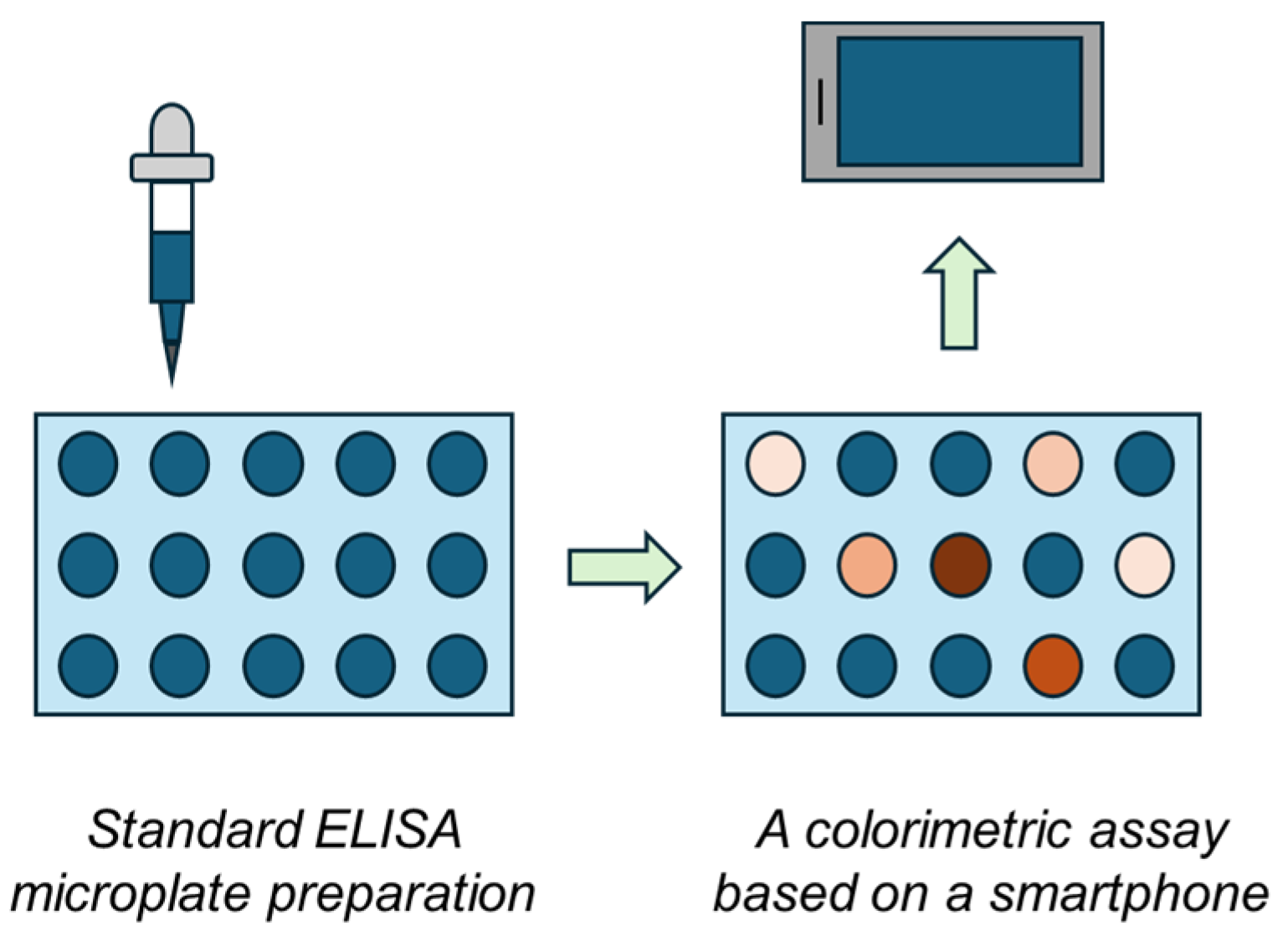

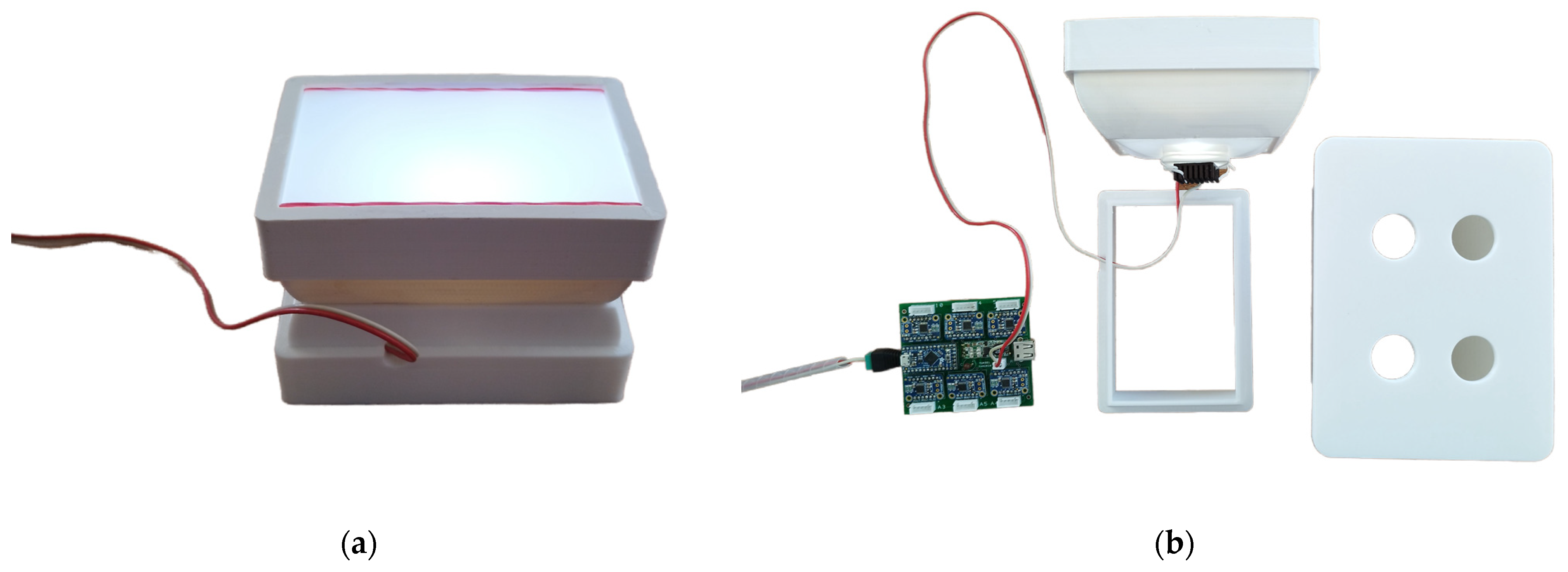
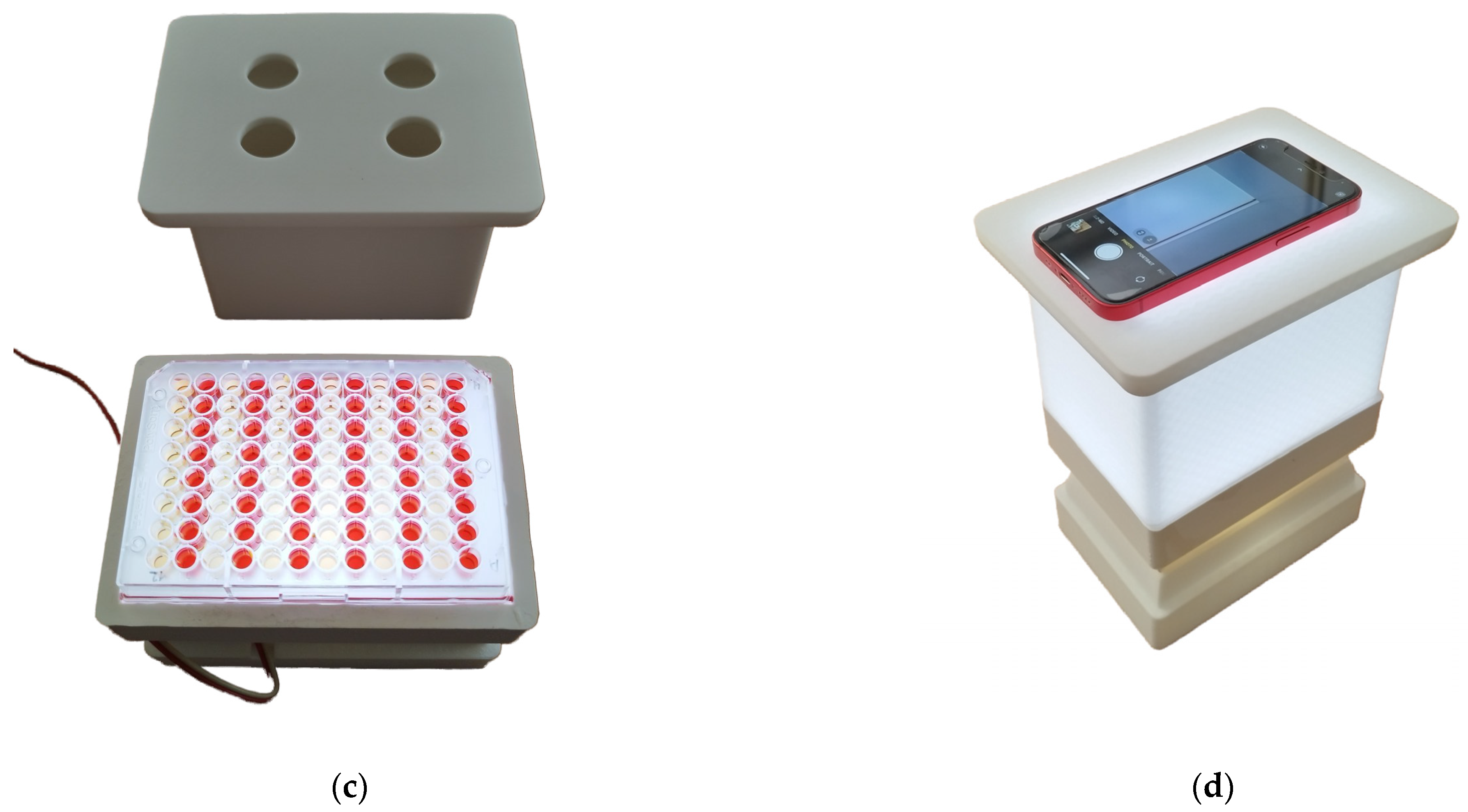
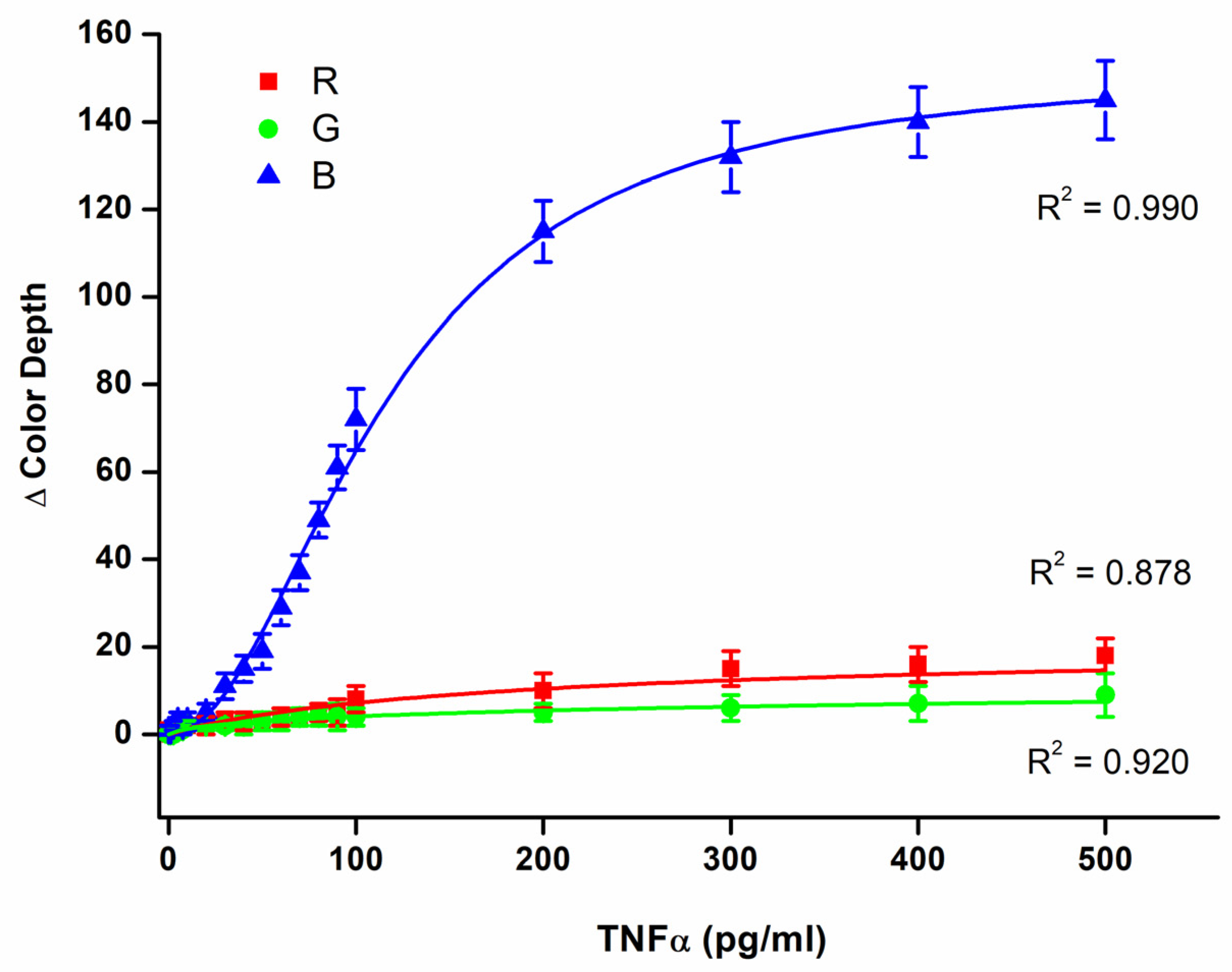

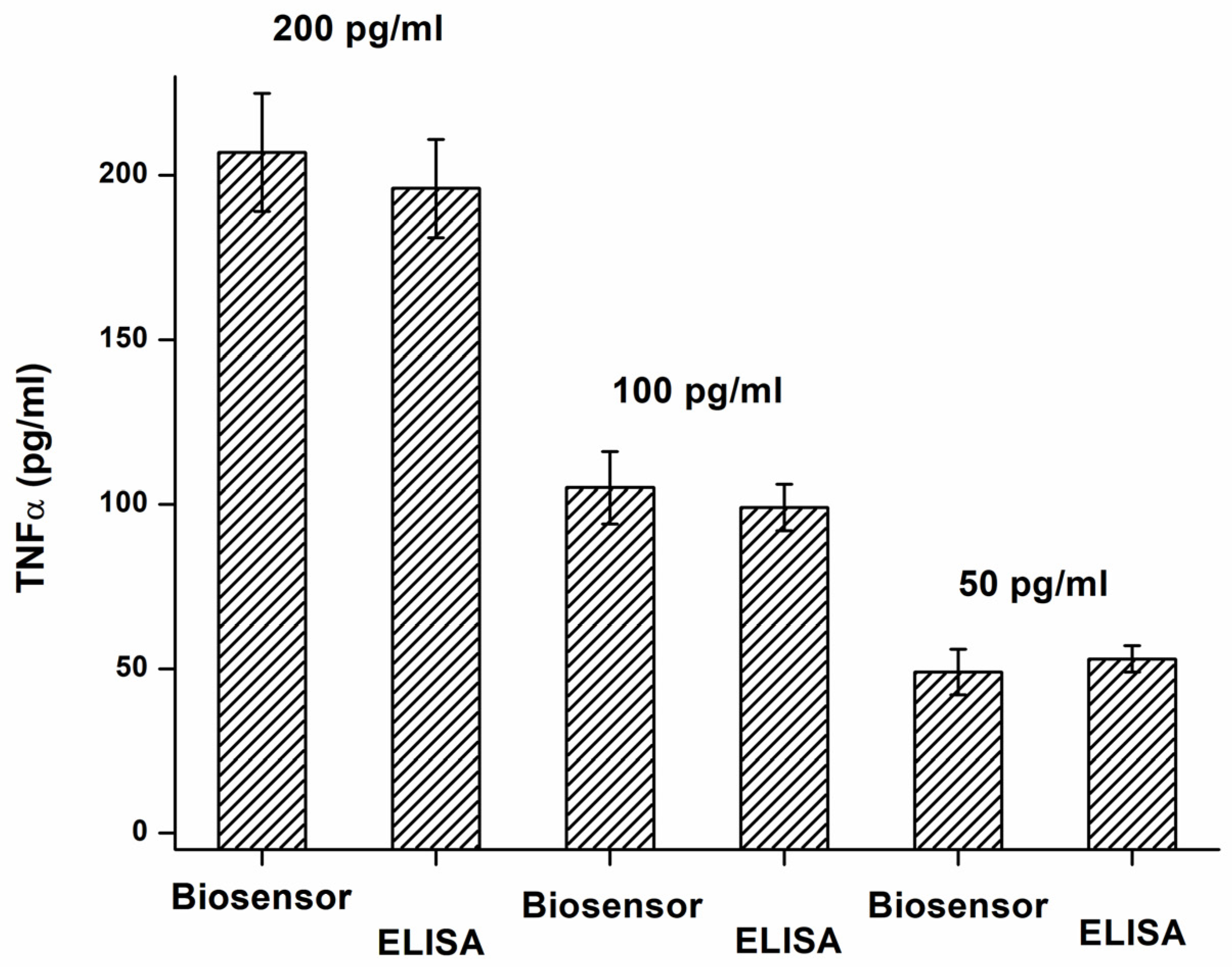
| Sample | TNFα (pg/mL) | RSD (%) | Recovery (%) |
|---|---|---|---|
| PBS | 105 ± 11 | 11 | - |
| Blood | 113 ± 15 | 13 | 108 |
| Plasma | 108 ± 13 | 12 | 103 |
| Urine | 98 ± 16 | 16 | 93.3 |
Disclaimer/Publisher’s Note: The statements, opinions and data contained in all publications are solely those of the individual author(s) and contributor(s) and not of MDPI and/or the editor(s). MDPI and/or the editor(s) disclaim responsibility for any injury to people or property resulting from any ideas, methods, instructions or products referred to in the content. |
© 2024 by the authors. Licensee MDPI, Basel, Switzerland. This article is an open access article distributed under the terms and conditions of the Creative Commons Attribution (CC BY) license (https://creativecommons.org/licenses/by/4.0/).
Share and Cite
Pohanka, M.; Keresteš, O.; Žáková, J. A 3D-Printed Do-It-Yourself ELISA Plate Reader as a Biosensor Tested on TNFα Assay. Biosensors 2024, 14, 331. https://doi.org/10.3390/bios14070331
Pohanka M, Keresteš O, Žáková J. A 3D-Printed Do-It-Yourself ELISA Plate Reader as a Biosensor Tested on TNFα Assay. Biosensors. 2024; 14(7):331. https://doi.org/10.3390/bios14070331
Chicago/Turabian StylePohanka, Miroslav, Ondřej Keresteš, and Jitka Žáková. 2024. "A 3D-Printed Do-It-Yourself ELISA Plate Reader as a Biosensor Tested on TNFα Assay" Biosensors 14, no. 7: 331. https://doi.org/10.3390/bios14070331






